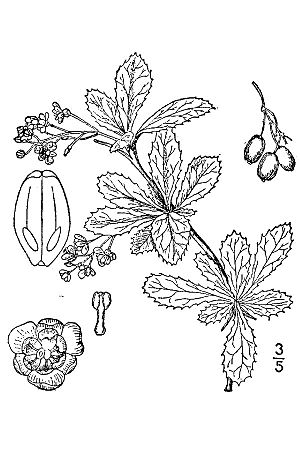American barberry facts for kids
Quick facts for kids American barberry |
|
|---|---|
 |
|
| Conservation status | |
| Scientific classification | |
| Genus: |
Berberis
|
| Species: |
canadensis
|
| Synonyms | |
|
|
Berberis canadensis, also known as the American barberry or Allegheny barberry, is a plant in the Berberidaceae family. This family includes many types of barberry plants. The American barberry is special because it is one of only two native barberry plants in the United States that have simple leaves. The other one is B. fendleri, which grows in the southwest U.S. The name "canadensis" means "Canadian." However, botanists in the 1700s often used this name for any plant found in northeastern North America.
Contents
What the American Barberry Looks Like
It can be tricky to tell the American barberry apart from a similar plant called B. vulgaris. B. vulgaris is a plant that was brought to the U.S. from other places.
Here are some ways to tell them apart:
- The branches that are two years old on the American barberry are brown, purple, or reddish. On B. vulgaris, they are usually grey.
- The American barberry has fewer "teeth" or jagged edges along its leaves.
- It also has fewer flowers in each cluster.
The American barberry is a shrub that loses its leaves in the fall. It usually grows about 1 meter (3 feet) tall, but can sometimes reach 2 meters (6.5 feet). It spreads using underground stems called rhizomes. These rhizomes help the plant get more nutrients from the soil. This allows the American barberry to grow well even in dry places.
The stems of the American barberry are smooth and do not have many branches. They can be green, purple, red, or brown. The leaves grow in an alternating pattern along the stem. They have small stalks, about 8 mm long, that are covered in a white, waxy coating. The leaves are thin, smooth, and oval-shaped. If you look closely at the underside of the leaves, you can see a pattern of veins.
Where the American Barberry Grows
The American barberry is native to 13 states in the United States. It naturally grows in the Appalachian Mountains, from southern Pennsylvania down to northern Georgia and Alabama. Some groups of these plants have also been found as far west as Missouri.
This plant mostly grows on rocky slopes on the sides of hills and mountains. The American barberry used to be much more common. However, it was found to be linked to a plant disease called wheat leaf rust, which harms wheat crops. Because of this, the United States government has slowly been removing the plant from many areas. It seems the plant has now found a balance with its environment. This means it is not spreading much further than its current range. Unlike many plants that are limited by weather, the American barberry is mostly limited by the type of soil and how open its habitat is.
Its Home and Neighbors
The American barberry grows in many different open environments. You can find it in dry woodlands or on exposed hillsides. It can also grow in various soil types, from basic to slightly acidic. The soil is usually shallow and drains water well. It gets moisture from occasional rainfall. The American barberry is a perennial plant, which means it grows back every year. It often grows alongside other plants that share its habitat.
Pretty Blooms and Tasty Berries
The flowers of the American barberry grow in clusters called a raceme. These clusters are usually about 2 to 5 centimeters (0.8 to 2 inches) long. Each flower has six petals that are cup-shaped and have small notches at their tips. The petals are arranged in two rows, with one petal sitting on top of another. The flowers can be yellow or a dull whitish-yellow. They have a bright green part called a stigma sticking out from the middle. The stamens, which are parts of the flower, move towards the stigma when something touches them.
The American barberry also produces small, bright red berries. These berries are safe to eat. They are oval-shaped and have a lot of acid, which gives them a pleasant tart taste.
How People Use the American Barberry
Food
Many people use the fruit of the American barberry. It is very rich in vitamin C. In the past, it was an important source of food for the native people of the southeastern United States. The juicy red berries can be cooked to make jelly. The juice from the berries is also a popular drink. Sometimes, the berries are crushed to make a paste that is similar to oatmeal. People have also used the berries to make alcoholic drinks.
Medicine
Native Americans, especially the Cherokee people, used the American barberry as a remedy for diarrhea. They would put the bark of the plant in water and then drink it to help ease the symptoms.




